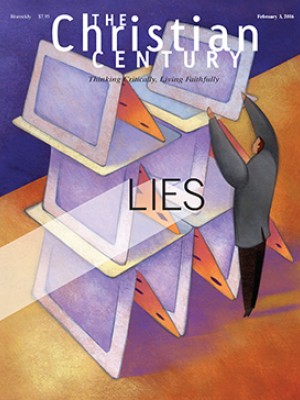February 21, Second Sunday in Lent: Luke 13:31-35
In December, we lost our last chicken. Hestia, a Buff Orpington hen, had been part of our household flock since it began in 2012. We saw raising chickens partly as an act of civil disobedience: our town didn’t permit animal husbandry inside city limits, and we didn’t see this as a very just law. Our flock eventually swelled to seven, but between predators, illness, and animal control enforcement, by last spring we only had Hestia.
As Hestia and her siblings grew up, they looked for places outside the coop to roost. My fluffy, curly, shoulder-length hair fit the bill. I would be sitting reading in our backyard when Hestia would flap up to my shoulder and nestle in my hair. It was quite a sensation. While I wouldn’t say I felt like a mother hen, I did realize how instinctual it was for her kind to find shelter and safety under a “wing.”
Read our latest issue or browse back issues.
Since then, I have heard Jesus’ avian simile in Luke 13:34 differently (his desire to gather the children of Jerusalem “as a hen gathers her brood”). But it wasn’t until I read Alan Culpepper’s reflections on this passage that I considered how Hestia’s death is just as evocative as the times she nestled in my hair.
Some context: Luke, more than the other Gospels, presents Jesus as taking a single journey to Jerusalem—a journey detailed at length as a distinct section of the overall narrative. From 9:51 through 19:27, Jesus is involved in what Jane Schaberg describes as “intensive training in discipleship,” public teaching through parables, and healing. As Jesus and his followers get closer to Jerusalem, the sobering realities of just how powerful—and therefore dangerous—his ministry is grow increasingly clear.
This week’s passage indicates this growing awareness as Jesus and his company wend their way throughout Galilee. Still in Herod’s territory, the Pharisees—whom we tend to regard as Jesus’ antagonists—have come to warn him that he’s treading on dangerous ground where the tetrarch is concerned. Jesus tells them to “go and tell that fox” that he’s busy.
What I hadn’t noticed before—mostly because I tend to encounter verses 31–33 and verses 34 and 35 as distinct units—is that Jesus contrasts the fox with a mother hen longing for her wayward chicks. “On the one side lurks the fox,” writes Culpepper in the New Interpreter’s Bible. “The Bible consistently depicts evil as dangerous and predatory, nothing one can flirt with without risking one’s life.” On the other side is an image that is redeeming and protective: “a mother hen who instinctively draws her young under her wing when danger threatens.”
Culpepper sees references to the Hebrew scriptures in Luke’s narrative, references that trace a pattern of perverted justice and foreshadow both Jesus’ death and Stephen’s: the stoning of God’s prophets such as Naboth (1 Kings 21:8–14) and Zechariah (2 Chron. 24:20–22). In other words, Herod is a very real threat to Jesus, but Jesus refuses to live in fear. Jesus and his growing community of disciples face a mixture of support and opposition, giving rise to both sadness and determination.
Hestia’s injury happened when my husband was out of town. After dinner with friends, I pulled into the driveway with our toddler and realized that the car’s headlights were illuminating a disturbing scene: a possum attacking our hen outside the shed. Frantic, I called my husband. With my son in one arm and my phone in the other, I couldn’t open the gate separating me from our poor chicken. No sound I made would deter the possum, and the lack of sound or movement from Hestia gave me the impression that she was dead.
We went into the house. I was overwhelmed at the prospect of dealing with Hestia’s remains in the morning. Then I heard her squawking cry—Hestia was not dead! Thanks to our next-door neighbors, her attacker was shooed off, and she was given first aid and shelter for the night. She made it through those long hours, but the possum had done serious damage to one of her wing joints. The best-case scenario was amputation; the challenge was finding a vet willing to do such a procedure. Each day that passed was a day that she was in a great deal of pain, infection spreading through her body. When my husband returned home, we made the decision to end Hestia’s misery and her life.
“We live in a menagerie,” Culpepper writes. “Evil threatens in the form of a fox, and the mother hen laments because her young are exposed but will not accept her protection.”
Hestia was a mature hen, not a chick. Had she ever hatched chicks herself, I’m sure she would have protected her young with ferocity and tenderness. But what I witnessed in the attack is that even adult chickens are susceptible to predators. Despite his self-assuredness and self-possession in the face of danger, Jesus, the mother hen, has no wing under which to find shelter.
It reminds me of an old Epiphany carol that tells the story of the Magi seeking assistance from another Herod. They tell him that the star shining so brightly in his realm signals the birth of a “princely babe no king shall e’er destroy.” This other fox of a king, who is dining on roasted rooster, doesn’t believe them:
If this be the truth, King Herod said,
That thou hast told to me,
The roasted cock that lies in the disk
Shall crow full senses three.
O the cock soon thrusted and feathered well,
By the work of God’s own hand,
And he did crow full senses three
In the disk where he did stand.
Long live the chicken.






